

Reichshund ("dog of the Empire") [1] [2] [3] was an informal term used in Germany for Reichskanzler Otto von Bismarck's dogs and more generally for similar dogs, particularly Great Danes.


Reichshund ("dog of the Empire") [1] [2] [3] was an informal term used in Germany for Reichskanzler Otto von Bismarck's dogs and more generally for similar dogs, particularly Great Danes.
Keeping dogs in Germany became increasingly fashionable as the 19th century continued, and people in public life often did so as part of their image. [4] Bismarck reportedly took a blonde Great Dane called Ariel with him when he entered the University of Göttingen in 1832. [5] He continued to keep Great Danes throughout the rest of his life. [n 1] His favourite was Sultan (shortened to 'Sultl' to avoid diplomatic repercussions with Turkey [6] ); on his deathbed he berated himself for not treating the dog better. [4] Sultan was a gift from the Bavarian Count Holnstein. [7] [8] After Sultan's death on 26 October 1877, Bismarck could only be consoled by the gift of another Great Dane from Count Holnstein, Tyras. [9] Tyras died on 18 January 1889; Emperor Wilhelm II gave Bismarck Tyras II for his birthday the following April 1. [10] The dog died on 11 May 1896. [11]
Bismarck also owned female Great Danes named Flora (nicknamed 'Flörchen'), who was Sultan's mate, and finally Rebecca (nicknamed Beckchen), [12] who died in 1897. After receiving Tyras II from the emperor, Bismarck regretfully gave Tyras I's offspring, Cyrus, whom he had hand-reared, to his head forester. [11] Bismarck's dogs were buried at his estate in Varzin, in Pomerania (now Warcino, Poland); the gravestones were rediscovered by students at the forestry institute that now occupies the manor. [13]
Accounts of the dogs' temperament vary. Some historians have regarded Bismarck's choice of the largest available breed and his habit of having a dog with him, which would disconcert foreign diplomats, as calculated demonstrations of power. [4] Former diplomat James Bryce, Viscount Bryce referred to the dog as "now and then growl[ing] and show[ing] its teeth in a threatening way", [3] and diplomat and President of Japan Kijūrō Shidehara said in a speech that "the dog threatened to bite anyone who would provoke his master's displeasure." [14] Robert K. Massie describes Tyras as "terrori[sing] the Chancellory staff" and writes that those who spoke with Bismarck were "advised to make no unusual gestures which Tiras might interpret as threatening." [15] On the other hand Tyras was said by one contemporary to have "never been guilty of any such ill-mannered act before" his celebrated misbehaviour, [2] and the English periodical The Spectator described him at the time as "a very quiet creature, with a most pacific reputation." [16]
Bismarck's dogs came to the public's attention and began to be called 'Reichshund' after Tyras attacked the Russian chancellor, Alexander Gorchakov, at the Congress of Berlin in 1878. [4] In some accounts, he knocked him to the ground, [2] [17] according to Massie after he raised his arm to make a point, [15] but according to The Spectator after he had stumbled and Bismarck had rushed to aid him. [16] However, Kladderadatsch published a front-page poem describing him as having torn the envoy's trousers. Its title was "An den Reichshund" - "To the Dog of the Empire". [18] [19] The poem misidentifies the offending dog as Sultan, who had already died.
The term Reichshund came to be used for Great Danes or similar dogs in general. [20] In Nancy Mitford's Wigs on the Green Eugenia's "enormous mastiff" is called the Reichshund "after Bismarck's dog". [21]
Some of the statues of Bismarck in Germany depict him with a dog, for example Max Klein's statue of him in Grunewald, Berlin (1897; melted down during World War II and recreated by Harald Haacke in 1996), Adolf Lehnert's statue of him in the Johannapark in Leipzig with a dog for whom Tyras II served as model (1895; destroyed) [11] and the statue of a young Bismarck by Norbert Pfretzschner erected by members of the student 'corps' on the Rudelsburg at Bad Kösen in 1896 (destroyed; recasting erected in 2006) depicts him with attributes of a corps member including a dog for whom Tyras I served as model. [4] Late-19th century student corps members included keeping large dogs among their traditions. [22]
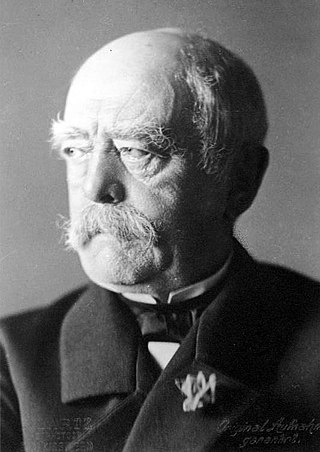
Otto, Prince of Bismarck, Count of Bismarck-Schönhausen, Duke of Lauenburg, born Otto Eduard Leopold von Bismarck, was a Prussian and later German statesman and diplomat. From his origins in the upper class of Junker landowners, Bismarck rose rapidly in Prussian politics, and from 1862 to 1890 he was the minister president and foreign minister of Prussia. Before his rise to the executive, he was the Prussian ambassador to Russia and France and served in both houses of the Prussian parliament. He masterminded the unification of Germany in 1871, and served as the first chancellor of the German Empire until 1890, in which capacity he dominated European affairs. He had served as chancellor of the North German Confederation from 1867 to 1871, alongside his responsibilities in the Kingdom of Prussia. He cooperated with King Wilhelm I of Prussia to unify the various German states, a partnership that would last for the rest of Wilhelm's life. The King granted Bismarck the titles of Count of Bismarck-Schönhausen in 1865 and Prince of Bismarck in 1871. Bismarck provoked three short, decisive wars against Denmark, Austria, and France. Following the victory against Austria, he abolished the supranational German Confederation and instead formed the North German Confederation as the first German national state, aligning the smaller North German states behind Prussia, while excluding Austria. Receiving the support of the independent South German states in the Confederation's defeat of France, he formed the German Empire – which also excluded Austria – and united Germany.

The Great Dane is a large sized dog breed originating from Germany. The Great Dane descends from hunting dogs from the Middle Ages used to hunt wild boar and deer, and as guardians of German nobility. It is one of the two largest dog breeds in the world, along with the Irish Wolfhound.
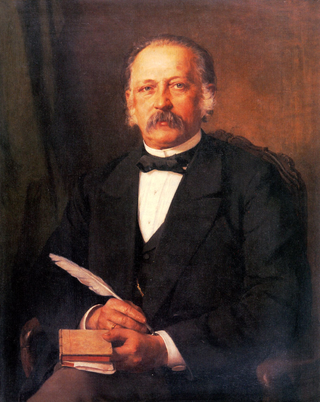
Theodor Fontane was a German novelist and poet, regarded by many as the most important 19th-century German-language realist author. He published the first of his novels, for which he is best known today, only at age 58 after a career as a journalist.

William I or Wilhelm I was King of Prussia from 2 January 1861 and German Emperor from 18 January 1871 until his death in 1888. A member of the House of Hohenzollern, he was the first head of state of a united Germany. He was de facto head of state of Prussia from 1858, when he became regent for his brother Frederick William IV. During the reign of his grandson Wilhelm II, he was known as Wilhelm the Great.

Baron Kijūrō Shidehara was a pre–World War II Japanese diplomat and politician. He was Prime Minister of Japan from 1945 to 1946 and a leading proponent of pacifism in Japan before and after World War II. He was the last Japanese Prime Minister who was a member of the peerage (kazoku). His wife, Masako, was the fourth daughter of Iwasaki Yatarō, founder of the Mitsubishi zaibatsu.

Georg Leo Graf von Caprivi de Caprara de Montecuccoli was a German general and statesman who served as the chancellor of the German Empire from March 1890 to October 1894. Caprivi promoted industrial and commercial development, and concluded numerous bilateral treaties for reduction of tariff barriers. However, this movement toward free trade angered the conservative agrarian interests, especially the Junkers. He promised educational reforms to the Catholic Center party which would increase their influence, but failed to deliver. As part of Kaiser Wilhelm's "new course" in foreign policy, Caprivi abandoned Bismarck's military, economic, and ideological cooperation with the Russian Empire, which historians consider a major mistake. Even worse, Caprivi misjudged multiple opportunities to open good relations with the United Kingdom of Great Britain and Ireland. Frustrated, Britain turned to the Empire of Japan and the French Third Republic for agreements. Caprivi's downfall came with trade agreements that favored German industry and urban workers over more powerful agricultural interests. Historians praise his refusal to renew the harsh restrictions on socialists, and his success in the reorganization of the German military.

Friedrich August Karl Ferdinand Julius von Holstein was a civil servant of the German Empire and served as the head of the political department of the German Foreign Office for more than thirty years. He played a major role in shaping foreign policy after Bismarck was dismissed in 1890.
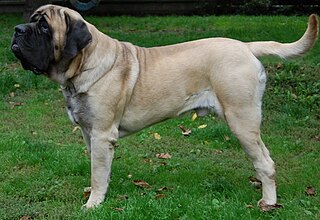
The English Mastiff, or simply the Mastiff, is a British dog breed of very large size. It is likely descended from the ancient Alaunt and Pugnaces Britanniae, with a significant input from the Alpine Mastiff in the 19th century. Distinguished by its enormous size, massive head, short coat in a limited range of colours, and always displaying a black mask, the Mastiff is noted for its gentle and loving nature. The lineage of modern dogs can be traced back to the early 19th century, but the modern type was stabilised in the 1880s and refined since. Following a period of sharp decline, the Mastiff has increased its worldwide popularity. Throughout its history the Mastiff has contributed to the development of a number of dog breeds, some generally known as mastiff-type dogs or, confusingly, just as "mastiffs". It is the largest living canine, outweighing the wolf by up to 50 kg on average.

Eduard Lasker was a German politician and jurist. Inspired by the French Revolution, he became a spokesman for liberalism and the leader of the left wing of the National Liberal party, which represented middle-class professionals and intellectuals. He promoted the unification of Germany during the 1860s and played a major role in codification of the German legal code. Lasker at first compromised with Chancellor Otto von Bismarck, who later strenuously opposed Lasker regarding freedom of the press. In 1881, Lasker left the National Liberal party and helped form the new German Free Thought Party.
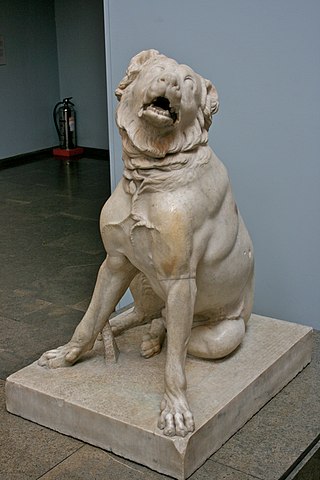
The Molossus was a breed of dog from Ancient Greece.

Lothar Machtan is a German historian, writer, as well as professor of Modern and Current History at the University of Bremen.
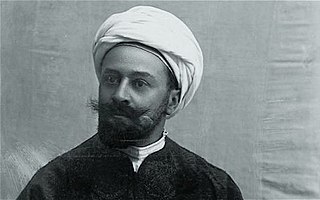
Baron Max von Oppenheim was a German lawyer, diplomat, ancient historian, and archaeologist. He was a member of the Oppenheim banking dynasty. Abandoning his career in diplomacy, he discovered the site of Tell Halaf in 1899 and conducted excavations there in 1911–13 and again in 1927–29. Bringing many of his finds to Berlin, he exhibited them in a private museum in 1931. This was destroyed by Allied bombing in World War II. However, most of the findings were recently restored and have been exhibited again at Berlin and Bonn.
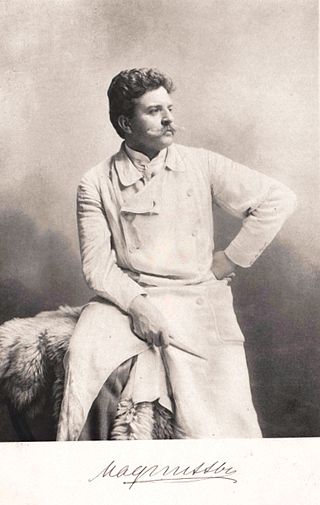
Harro Magnussen was a German sculptor.

The Raid on Scarborough, Hartlepool and Whitby on 16 December 1914 was an attack by the Imperial German Navy on the British ports of Scarborough, Hartlepool, West Hartlepool and Whitby. The bombardments caused hundreds of civilian casualties and resulted in public outrage in Britain against the German Navy for the raid and the Royal Navy for failing to prevent it.

Ernst Ludwig von Gerlach was a Prussian politician, editor and judge. He is considered one of the main founders and leading thinkers of the Conservative Party in Prussia and was for many years its leader in the Prussian House of Representatives. Like his brother Leopold von Gerlach, he belonged to the circle that formed around the Neue Preußische Zeitung, in the founding of which he also played a leading role.
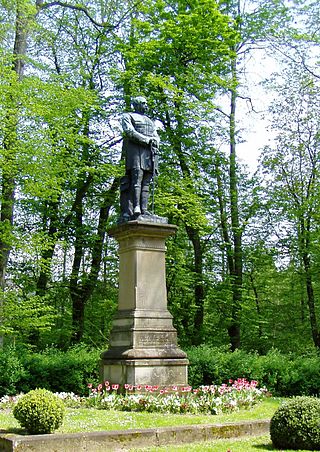
From 1868 onwards, Bismarck monuments were erected in many parts of the German Empire in honour of the long-serving Prussian minister-president and first German Reichskanzler, Prince Otto von Bismarck. Today some of these monuments are on the soil of other countries including France, Poland and Russia as well as the former German colonies on other continents.
SMS V1 was a V1-class torpedo boat of the Imperial German Navy. The ship was built by AG Vulcan, completing in 1912. She served in the First World War with the German High Seas Fleet, taking part in the Battle of the Heligoland Bight in 1914 and the Battle of Jutland in 1916. She was retained by the post-war German Navy and was stricken in 1929 and scrapped.

The Marquesan Dog or Marquesas Islands Dog is an extinct breed of dog from the Marquesas Islands. Similar to other strains of Polynesian dogs, it was introduced to the Marquesas by the ancestors of the Polynesian people during their migrations. Serving as a tribal totems and religious symbols, they were sometimes consumed as meat although less frequently than in other parts of the Pacific because of their scarcity. These native dogs are thought to have become extinct before the arrival of Europeans, who did not record their presence on the islands. Petroglyphic representations of dogs and the archaeological remains of dog bones and burials are the only evidence that the breed ever existed. Modern dog populations on the island are the descendants of foreign breeds later reintroduced in the 19th century as companions for European settlers.
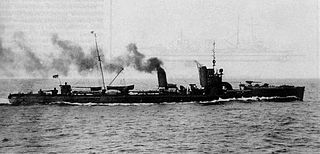
SMS V2 was a V1-class torpedo boat of the Imperial German Navy. The ship was built by AG Vulcan, completing in 1912. She served in the First World War with the German High Seas Fleet, taking part in the Battle of the Heligoland Bight in 1914 and the Battle of Jutland in 1916. She was retained by the post-war German Navy and was stricken in 1929 and scrapped.
SMS G9 was a V1-class large torpedo boat of the Imperial German Navy. She was built by the Germaniawerft shipyard at Kiel between 1911 and 1912, completing on 25 September 1912.